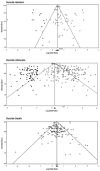Self-injurious thoughts and behaviors as risk factors for future suicide ideation, attempts, and death: a meta-analysis of longitudinal studies
- PMID: 26370729
- PMCID: PMC4774896
- DOI: 10.1017/S0033291715001804
Self-injurious thoughts and behaviors as risk factors for future suicide ideation, attempts, and death: a meta-analysis of longitudinal studies
Abstract
Background: A history of self-injurious thoughts and behaviors (SITBs) is consistently cited as one of the strongest predictors of future suicidal behavior. However, stark discrepancies in the literature raise questions about the true magnitude of these associations. The objective of this study is to examine the magnitude and clinical utility of the associations between SITBs and subsequent suicide ideation, attempts, and death.
Method: We searched PubMed, PsycInfo, and Google Scholar for papers published through December 2014. Inclusion required that studies include at least one longitudinal analysis predicting suicide ideation, attempts, or death using any SITB variable. We identified 2179 longitudinal studies; 172 met inclusion criteria.
Results: The most common outcome was suicide attempt (47.80%), followed by death (40.50%) and ideation (11.60%). Median follow-up was 52 months (mean = 82.52, s.d. = 102.29). Overall prediction was weak, with weighted mean odds ratios (ORs) of 2.07 [95% confidence interval (CI) 1.76-2.43] for ideation, 2.14 (95% CI 2.00-2.30) for attempts, and 1.54 (95% CI 1.39-1.71) for death. Adjusting for publication bias further reduced estimates. Diagnostic accuracy analyses indicated acceptable specificity (86-87%) and poor sensitivity (10-26%), with areas under the curve marginally above chance (0.60-0.62). Most risk factors generated OR estimates of <2.0 and no risk factor exceeded 4.5. Effects were consistent regardless of sample severity, sample age groups, or follow-up length.
Conclusions: Prior SITBs confer risk for later suicidal thoughts and behaviors. However, they only provide a marginal improvement in diagnostic accuracy above chance. Addressing gaps in study design, assessment, and underlying mechanisms may prove useful in improving prediction and prevention of suicidal thoughts and behaviors.
Keywords: Longitudinal; meta-analysis; prediction; suicidal ideation; suicide; suicide attempt.
Figures


Comment in
-
Letter to the Editor: Self-injurious thoughts and behaviours: low predictive power, yet important risk factors?Psychol Med. 2016 Jul;46(9):2008. doi: 10.1017/S0033291716000416. Epub 2016 Mar 11. Psychol Med. 2016. PMID: 26964633 No abstract available.
Similar articles
-
Longitudinal association between self-injurious thoughts and behaviors and suicidal behavior in adolescents and young adults: A systematic review with meta-analysis.J Affect Disord. 2017 Jun;215:37-48. doi: 10.1016/j.jad.2017.03.035. Epub 2017 Mar 12. J Affect Disord. 2017. PMID: 28315579 Review.
-
Prevalence and Correlates of Suicide and Nonsuicidal Self-injury in Children: A Systematic Review and Meta-analysis.JAMA Psychiatry. 2022 Jul 1;79(7):718-726. doi: 10.1001/jamapsychiatry.2022.1256. JAMA Psychiatry. 2022. PMID: 35612875 Free PMC article.
-
Suicide attempts before joining the military increase risk for suicide attempts and severity of suicidal ideation among military personnel and veterans.Compr Psychiatry. 2014 Apr;55(3):534-41. doi: 10.1016/j.comppsych.2013.10.006. Epub 2013 Oct 22. Compr Psychiatry. 2014. PMID: 24246604
-
Depression and hopelessness as risk factors for suicide ideation, attempts and death: meta-analysis of longitudinal studies.Br J Psychiatry. 2018 May;212(5):279-286. doi: 10.1192/bjp.2018.27. Epub 2018 Mar 28. Br J Psychiatry. 2018. PMID: 29587888
-
The role of cytokines in the pathophysiology of suicidal behavior.Psychoneuroendocrinology. 2016 Jan;63:296-310. doi: 10.1016/j.psyneuen.2015.10.008. Epub 2015 Oct 19. Psychoneuroendocrinology. 2016. PMID: 26546783 Free PMC article. Review.
Cited by
-
Electronic Health Record Phenotyping of Pediatric Suicide-Related Emergency Department Visits.JAMA Netw Open. 2024 Oct 1;7(10):e2442091. doi: 10.1001/jamanetworkopen.2024.42091. JAMA Netw Open. 2024. PMID: 39470636 Free PMC article.
-
Risky decision-making and nonsuicidal self-injury among university students: Examining the role of criticism feedback.PLoS One. 2024 Oct 25;19(10):e0312081. doi: 10.1371/journal.pone.0312081. eCollection 2024. PLoS One. 2024. PMID: 39453931 Free PMC article.
-
Moderators and predictors of treatment outcome following adjunctive internet-delivered emotion regulation therapy relative to treatment as usual alone for adolescents with nonsuicidal self-injury disorder: Randomized controlled trial.JCPP Adv. 2024 May 6;4(3):e12243. doi: 10.1002/jcv2.12243. eCollection 2024 Sep. JCPP Adv. 2024. PMID: 39411472 Free PMC article.
-
Validity, Reliability, and Factor Structure of the Suicide Crisis Scale in Turkish.Alpha Psychiatry. 2024 Aug 1;25(4):502-512. doi: 10.5152/alphapsychiatry.2024.241564. eCollection 2024 Aug. Alpha Psychiatry. 2024. PMID: 39360296 Free PMC article.
-
Solution-focused approaches for treating self-injurious thoughts and behaviours: a scoping review.BMC Psychiatry. 2024 Oct 1;24(1):646. doi: 10.1186/s12888-024-06101-7. BMC Psychiatry. 2024. PMID: 39354404 Free PMC article. Review.
References
-
- Adam KS, Valentine J, Scarr G, Streiner D. Follow-up of attempted suicide in Christchurch. Australian and New Zealand Journal of Psychiatry. 1983;17:18–25. - PubMed
-
- Anderson HD. Suicide ideation, depressive symptoms, and out-of-home placement among youth in the US child welfare system. Journal of Clinical Child & Adolescent Psychology. 2011;40:790–796. - PubMed
-
- Asarnow J, Porta G, Spirito A, Emslie G, Clarke G, Wagner K, Vitiello B, Keller M, Birmaher B, McCracken J, Mayes T, Berk M, Brent D. Suicide attempts and nonsuicidal self-injury in the treatment of resistant depression in adolescents: findings from the TORDIA study. Journal of the American Academy of Child & Adolescent Psychiatry. 2011;50:772–781. - PMC - PubMed
-
- Bagley C, Greer S. Clinical and social predictors of repeated attempted suicide: a multivariate analysis. British Journal of Psychiatry. 1971;119:515–552. - PubMed
-
- Beck A, Schuyler D, Herman I. Development of suicidal intent scales. In: Beck A, Resnik CL, Lettieri D, editors. The Prediction of Suicide. Charless Press; Bowie, MD: 1974. pp. 45–56.
Publication types
MeSH terms
Grants and funding
LinkOut - more resources
Full Text Sources
Medical
Miscellaneous

